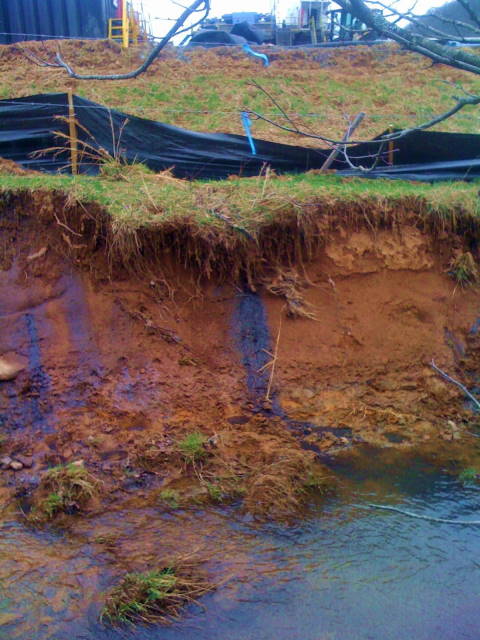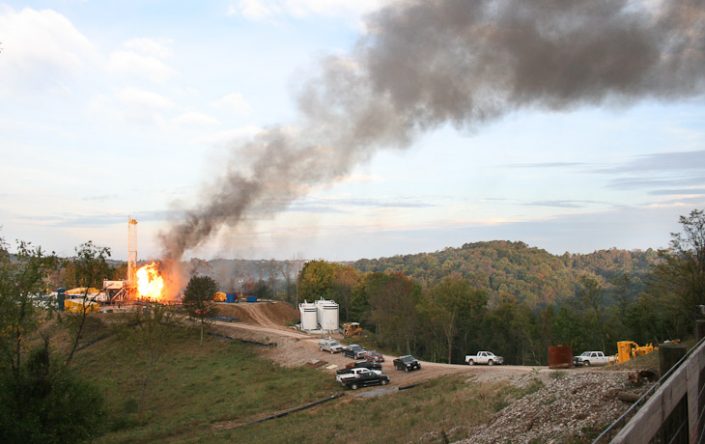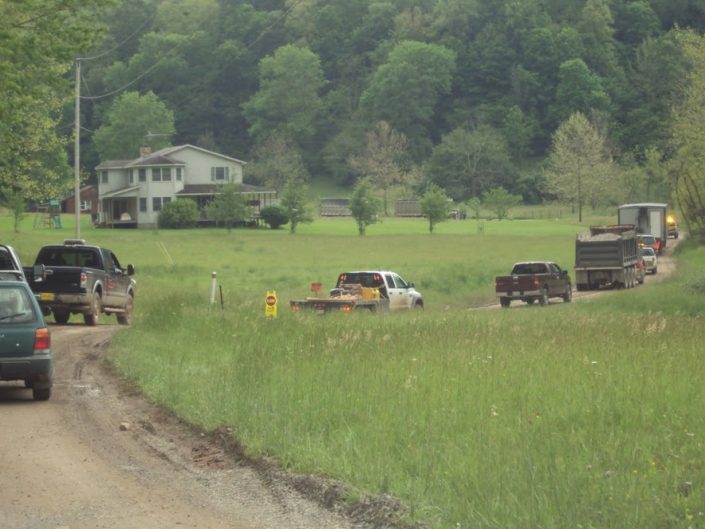Underground Gas Storage Wells – An Invisible Risk in the Natural Gas Supply Chain
The largest accidental release of methane in U.S. history began October 23, 2015 with the blowout of an underground natural gas storage well in Aliso Canyon about 20 miles west of Los Angeles. By the time the well was plugged 112 days later, more than 5.0 billion cubic feet of methane and other pollutants had been released to the atmosphere. It was a disaster for the climate, the environment, California’s energy supply, and the more than 11,000 people that were forced to evacuate.
A new study from the Harvard T. H. Chan School of Public Health – Center for Health and the Global Environment shows that more than one in five of the almost 15,000 active underground gas storage (UGS) wells in the US could be vulnerable to serious leaks due to obsolete well designs – similar in design to the well that failed at the Aliso Canyon storage facility.
Published today in the journal Environmental Research Letters, the study presents a national baseline assessment of underground storage wells in the U.S. and indicates the need for a better understanding of the risks associated with the obsolescence of aging storage wells. The study also highlights the widespread nature of certain age-related risk factors, but indicates that some of the highest priority wells may be located in PA, OH, NY, and WV.
The study shows that the average construction year of largely unregulated active UGS wells in the US is 1963, with potentially obsolete wells that were not originally designed for storage operating in 160 facilities across 19 states. Some of the wells were constructed over 100 years ago – a time period that precedes many modern well containment systems such cement isolation and the use of multiple casings. Some of the oldest active UGS wells were not designed for two-way flow of gas, and therefore may not exhibit sufficient material-grade or redundant precautionary systems to prevent containment loss, as was evident at Aliso Canyon.
An Interview with the Author
Sam, Matt, and Kyle of FracTracker caught up with lead author and former FracTracker colleague, Dr. Drew Michanowicz, now with the Center for Health and Global Environment within the Harvard T. H. Chan School of Public Health to find out more about their study.
When we spoke with Drew, he began the interview by posing the first question to us:
Did you know that about 15% of the natural gas produced in the US is injected back into the ground each year?
While we had all heard of underground gas storage before, we had to admit that we never thought of the process like that before. In other words, some of the natural gas in the US is being produced twice from two different reservoirs before being consumed. And because many of these storage systems utilized depleted oil and gas reservoirs, many of the same pre- and post-conditioning processes, such as dehydrating and compressing, are necessary to bring the gas to market.
The following questions and answers from Drew expand upon the study’s findings:
Q: What prompted you and your colleagues to investigate this topic?
A: After the Aliso Canyon incident, we became interested in the question: ‘Is Aliso Canyon Unique?’ Interestingly, there were plenty of early warning signs at that facility that corrosion issues on very old repurposed wells were becoming a significant issue. Almost a year before the well blowout, Southern California gas went on record in front of California’s Public Utility Commission stating that they needed a rate increase to implement a necessary integrity management plan for their wells, and to be able to move beyond operating in a reactive mode. That unfortunately prophetic document really got us interested in better understanding why their infrastructure was in the state it was in. And like any major accident like this, a logical next step is to assess the prevalence of hazardous conditions elsewhere in the system, in the hope to prevent the next one.
From our research, it appears that a very large portion of the UGS sector may be facing similar obsolescence issues compared to Aliso, such as decades-old wells not originally designed for two-way flow. Our work here, however, is a simplified assessment that focused only on passive barriers or the fixed structures such as the steel pipes likely present in a well. Much more work is needed to fully understand the active-type safety measures in place such as safety valves, tubing/packers, and overall integrity management plans – all important factors for manage risks.
Q: We see that your team developed a well-level database of over 14,000 active UGS wells across 29 states. Because data-collation is a big part of our work here, can you describe that data collection process?
A: Very early on we also realized that underground gas storage was exempt from the Safe Drinking Water Act’s Underground Injection Control (UIC) program – similar to exemption with hydraulic fracturing and the Energy Policy Act of 2015, AKA the Halliburton Loophole. This meant in part that very little aggregate well data was available from the Federal Government or by third-party aggregators like FracTracker and DrillingInfo. Reminiscent of my former extreme data-paucity days at FracTracker, we knew we needed to build a database basically from scratch to effectively perform a hazard assessment that incorporated a spatial component.
We began by gathering what data we could from the U.S. Energy Information Administration (EIA), which gave us good detail at the field or facility level, but the fields were generalized to a county centroid. So to fully evaluate these infrastructure, we needed to figure out how to join the facility-level data to the well data for each state. We relied on NETL’s Energy Data eXchange to identify state-level wellbore data providers where applicable. Once we collected all of the state data, we created a decision-tree framework to join the individual wells to the EIA field names in order to produce a functional geodatabase. Because we had to manage data from so many sources, we had to devote quite a bit of effort to data QA/QC, and that is reflected in the methods and results of the paper. For example, some of our fields and wells had to be joined via visual inspection of company system maps, because of missing identifier information.
Q: We see that some of the oldest repurposed wells you mapped are located in PA, OH, NY, and WV. Was that a surprise to you?
A: That was a surprise considering this story started for us in California, and even more surprising was that some are more than 100 years old. Now, a bit of caution here is warranted when thinking about the age of any engineered system. On the one hand, something that functions for a very long time is an indication that the system was very well suited for its task, and likely has been very well taken care of – think of an antique automobile like a fully functional 1916 Model T Ford, for example. On the other hand, age and construction year relates to the integrity of an engineered system through two processes by:
- providing information to how long a system has been exposed to natural degradation processes such as corrosion, and stresses from thermal and abrasive cycles; and by
- proxying for knowledge and regulatory safety standards at the time of construction which informs the design, materials, technologies likely used.
To go back to the car example, while an old classic car may still be operational, it may not have certain safety features like antilock brakes, airbags, or safety belts, and generally will not be able to go as fast as a modern car. Therefore, a gas storage well’s integrity is at least indirectly related to its construction year when considering the multitude of technological and safety improvements have occurred over the years. This is how we have been thinking about well integrity from a 5,000 foot perspective. Needless to say, more research is needed to understand the causal effect of age on well integrity.
Q: So if we understand you correctly, these older wells can be maintained with sufficient management practices, but there may be inherent safety features missing on these older wells that don’t adhere to todays’ standards?
A: That’s right. So what we can say about some of these aging wells is that some will not reflect certain modern fail-safe engineering such as sufficient casing design strength and multiple casings or barriers along the full length. And these are permanent structural elements vestigial to the well’s original design, and therefore cannot be undone or redesigned away. In other words, it makes much more sense to drill a new well with new materials than attempt to significantly alter an old well. And the gas storage wells built today are designed with redundant fail-safe systems including multiple barriers and real-time pressure sensors.
But back to my earlier point about lack of federal regulations to set a minimum safety standard – because of that, there is also much uncertainty surrounding how many of these facilities have been dealing with safety and risk management. That is a future direction of this work – to really try to fill in some of regulatory gaps between states and the impending Federal guidelines and identify some best practices to help inform policy makers specifically at the state level.
Drew put together a map to highlight where some of these active storage wells are in PA, OH, NY, and WV:
This area map of PA, WV, OH, and NY displays where active underground natural gas storage operations are located. The small white points represent active storage wells that have a completion, SPUD, or permit date that occurs after the field was designated for storage indicating that these wells are more likely to have been designed for storage operations. The green points are active storage wells that predate storage operations, indicating that these wells may not have been designed for storage.
There are 121 storage fields connected to at least 6,624 active gas storage wells across these four states. A portion of wells in this region were not included in this final count because they did not contain sufficient status or date information. Pennsylvania has the most individual storage fields of any state with 47, while Ohio boasts the most active storage wells of any state in the country with 3,318 across its 22 active fields. Of the 6,624 active UGS wells across these four states, 1,753 predate storage designation indicating that these wells were likely not originally designed for storage. These ‘repurposed’ wells have a median age of 84 years, with 210 wells constructed over 100 years ago (red points). The 100 year cutoff is not arbitrary, as the year 1917 marks the advent of cement zonal isolation techniques, indicating that these wells may be of the highest priority in terms of design deficiencies related to well integrity, and they are primarily located across the four states pictured above.
Top Counties with Obsolete1/Repurposed2 Wells
- Westmoreland, PA (86/93)
- Ashland, OH (50/217)
- Richland, OH (31/99)
- Greene, PA (25/76)
- Hocking, OH (18/99)
1Obsolete wells are repurposed wells constructed before 1916
2Repurposed wells predate the storage facility
Additional Notes
The well that failed at Aliso Canyon was originally drilled in 1954 for oil production. In 1972, it was repurposed for underground gas storage, which entails both production and injection cycles in a single well. The problem seems to be that because it was not originally constructed to store natural gas, only a single steel pipe separated the flow of gas and the outside rock formation. That meant the well’s passive structural integrity was vulnerable to a single point-of-failure along a portion of its casing. When part of the subsurface well casing failed, there were no redundancies or safety valves in place to prevent or minimize the blow out.


